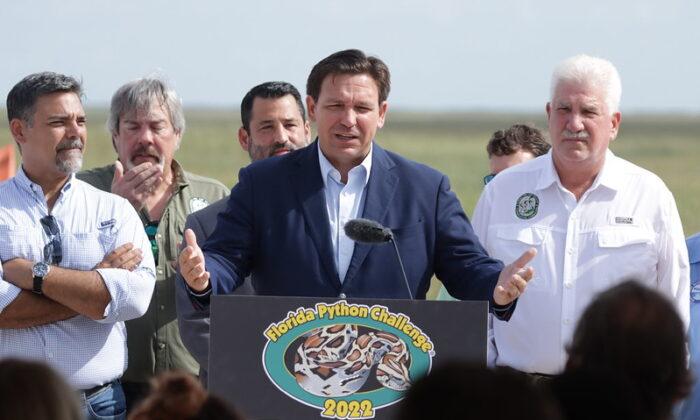PUNTA GORDA, Fla.–The Everglades Foundation’s chief science officer is meeting Gov. Ron DeSantis’ Florida Python Challenge by lending his expertise to help eradicate the invasive species and allow the Everglades to thrive.
Burmese Pythons blend well with the marshy environment of the Everglades, he says, and the key is learning how to detect them.
“Our wildlife biologists tell us that for every python we see, there are probably 100 to 1,000 others that we’re not seeing.” Steve Davis PhD told The Epoch Times on June 21 in a telephone interview. “Our ability to detect them needs to improve.”
Over the years, state agencies have used different methods to track and eradicate the snakes. Technology is utilized to locate them with drones and thermal tracking as well as detection dogs and even a “Judas Snake,” which Davis described as a large python that is “tagged with GPS in hopes that it will lead to other snakes.” But none of the efforts put forth have had much success, he said. The only successful method has been Florida’s annual Python Challenge where everyday Americans, after taking an online class and registering with the state can hunt pythons for prize money.

The Python Challenge brings awareness to the problem that the ecosystem is negatively impacted, and leads to thousands of pythons being removed, he said.
Boots on the ground seem to be the one “foolproof” way of ridding the Everglades of the nuisance snake but in order to find them one must be “well trained.”
They blend in so well “you could be standing on top of one and would not know that it’s there unless it moves,” Davis said.
He said the python lays eggs twice a year and can lay 50 to 80 eggs at one time. However, not all the eggs hatch because birds and animals eat them, and often the ones that hatch are eaten by other wildlife. It is the large snakes that concern Davis as, while researching the area, he has witnessed pythons fighting with native species.
“We have had well-documented instances of run-ins between large alligators and large pythons, and it never ends well,” he said. “Usually, one or more or both of them end up dying.”
“They (pythons) are very efficient at consuming small mammals,” Davis said. “Marsh rabbits have disappeared–raccoons, marsh rats and other small mammals have largely disappeared because of the python.”
At a press conference on June 16, DeSantis announced that he would “supercharge efforts to get more pythons out of the Everglades,” by opening registration for the 2022 Python Challenge to give more people the opportunity to be involved in protecting and being “good stewards” of the Everglades.

“We’ve worked hard on conserving Florida’s natural resources and to make sure that we were taking a unique piece of property that God has given us and leaving it to the next generation better than we found it,” the governor told a group at a press conference in the Everglades.
Since taking office in 2019, the governor has initiated 48 Everglades projects that have either broken ground or finished construction—including the EAA reservoir project, which was one of his top priorities that has cost millions of dollars.
Wearing a pair of python boots his wife Casey had bought him as a gift for Christmas, DeSantis explained that the area was a “diverse ecosystem” and the toll the invasive species is taking on the landscape is “unbelievable.”
“We viewed this as a challenge,” he said. “We wanted to supercharge those efforts and get more and more pythons out of the Everglades so our wildlife could thrive.”
In 2021, 600 people from 25 states descended on the Everglades and removed 223 snakes in the 10-day challenge. Since 2000, more than 13,000 pythons have been eradicated as a result of the state’s annual contest. Pythons may be killed at any time throughout the years from any of the 25 Florida Wildlife Management areas, Public Small Game Hunting Areas, and Wildlife and Environmental areas where they are known to be.
Burmese pythons were first brought to Florida as exotic pets and then released into the wild by owners who couldn’t maintain them, Davis explained. Their rapid growth is also connected to 1992’s Hurricane Andrew, which destroyed a Burmese python breeding facility, releasing hundreds of individual snakes into the wild.
Davis said they have thrived because of the climate and vegetation in the Everglades. In his research, he said he has found that “with Everglades restoration and putting more water back into the Everglades can actually improve conditions for the native species to allow them to find a better balance.”
“One of the things that we are learning is that the areas where they seem to be doing best are the parts of the Everglades that are over drained,” he said. “By finding a better balance with these pythons–we’re likely to live with them decades into the future ... unless we can find a way to exterminate all of them, we’re going to be dealing with pythons for quite some time to come.”
The event, which runs August 5-14, is hosted by the Florida Fish and Wildlife Conservation Commission (FWC) and the South Florida Water Management District (SFWMD). Registration is required along with a mandatory online class.
Davis said that hunting pythons for the Python Challenge is not like a new “TikTok challenge” and taking and passing the course that the state offers is “very important” in order to know “what to look for and how to look for it.”




